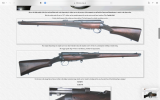View attachment 508187
There is a misconcetion that the Lee Speed was or is a particular rifle but in reality the name Lee Speed pertains to the rear locking bolt and the detachable magazine with the Patents held by Joseph J. Speed, and not the stock stock style. What we now call the Lee Speed was originally simply called the BSA Sporting Rifle
The Lee-Speed Rifle
The name "Lee Speed" comes from two designers' names--James Paris Lee, who invented the action that was used in all the Lee Metford and Lee Enfield military rifles---and Joseph Speed, RSAF designer, who took out patents on many of the features we associate with the Lee Enfield series of rifles. The term "Lee Speed" was used for commercial rifles (i.e., non-Government; intended for civilian sales). These rifles were mostly manufactured by the BSA company (who also made Gov't rifles, so they had the machinery in place to make sporting versions very economically), and many are stamped with the BSA logo. However, other companies also sold them, and put their own stamps on them--so you will find some Lee Speed rifles that are marked W.W. Greener, Army & Navy, Manton, etc. The "Lee Speed" was stamped on the rifles to indicate the patent holders The easiest way to tell if it's a commercial vs. Gov't rifle is the markings. Military rifles will have the sovereign's stamp; commercial guns will not.
Patents were held by James Paris Lee (bolt and mag) and by Joseph Speed (mag) and so had to be marked on commercial arms sold to the public.
Lee Speeds were built by BSA and LSA 1890 - 1914. After that the patent expired and was no longer marked on the rifle. So technically, there were no Lee Speeds after 1918, but the name stuck and all factory BSA & LSA sporters got the handle Lee Speed.
There were also volunteer arms available for purchase, full blown military specs, so these are also 'Lee Speeds' but usually don't get called by that nick name.
The original incarnation of the most well known of all British service rifles was the Rifle, Magazine, Lee-Metford, adopted in 1888 just as several other major powers were adopting nitrocellulose small bore cartridges and new magazine rifles. It was named, in British convention of the era, for the bolt action of Canadian gun designer James Paris Lee and the rifling design of William Ellis Metford. Lee's bolt action design had its antecedents in his prior Model 1879 and Remington-Lee 1885 rifles for the United States Navy, but the design made for the British was a significant improvement over these and featured a 10-round box magazine fed by an
en bloc charger, offering unheard of firepower. Metford's gently-rounded polygonal rifling pattern had been a mainstay of the military-match world for almost two decades (notably in the Gibbs-Farquharson-Metford and Deeley-Edge-Metford rifles) and was regarded by many experts as being superior in accuracy and minimizing blackpowder fouling when compared to Alexander Henry's angular rifling pattern.
The Lee-Speed resulted from design improvements introduced by Joseph J. Speed, a manager and later Superintendent of the Enfield Royal Small Arms Factory (RSAF). Among these were the safety lever on the bolt and alterations to the magazine to incorporate a 10-round detachable box. Speed's design improvements became standard on the Lee-Metford and later Lee-Enfield rifles, but the rifles produced by the Birmingham Small Arms (BSA) factory for commercial sale were often named Lee-Speed in recognition of Joseph Speed's innovations rather than Lee-Metford, even though the Metford rifling was most typically used in sporting arms even after it was superceded by the Enfield rifling pattern in the military rifles in 1895 to improve barrel life with nitrocellulose propellant (it was concluded, apparently, that the rate and volume of fire for sporting arms did not pose this concern).
"BSA made such rifles from 1892 until at least the 1930s, possibly (but unlikely) even later. The sporting versions were built on the early, pre-charger bridge Lee Metford/Lee Enfield actions, the bolt cover giving them a very sleek and elegant appearance. Later sporters were offered on the charger-bridged MkIII actions
View attachment 508186
 Compared to here, they seem to go for a song on the UK auction sites.
Compared to here, they seem to go for a song on the UK auction sites.

